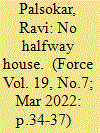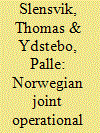| Srl | Item |
| 1 |
ID:
187185


|
|
|
| 2 |
ID:
146916


|
|
|
|
|
| Summary/Abstract |
The second revision of the Norwegian Joint Operational Doctrine (NJOD) is an example of how a small state within the NATO framework presents a national ambition of conducting joint operations. Even if NATO doctrine is the cornerstone for the application of military force in Norway, there are some unique conditions and ambitions that Norway has chosen to put into its own doctrine. With the revision, Norway has institutionalized and formalized the doctrine process based upon the experience from earlier efforts and the NATO procedures. It has established a process that ensures a continuous doctrine cycle with few resources and can easily draw on more resources in a project-based development if need be. The process is discussed on the basis of the official minutes from the relevant meetings. This gives a unique insight in the process, and the challenges and solutions a small nation meets in creating national doctrines.
|
|
|
|
|
|
|
|
|
|
|
|
|
|
|
|
| 3 |
ID:
153324


|
|
|
|
|
| Summary/Abstract |
This article analyses the doctrine development of the People’s Liberation Army (PLA) coping with the Soviet military threat between 1969 and 1989. In the 1970s, the PLA applied a doctrine of ‘active defence and luring the enemy into depth’ based on its traditional operational art. In 1980, the PLA decided to focus its doctrine on positional defence. In 1986, the PLA introduced ‘integrated operations and prioritised strike’, a generalised doctrine that originated from its war history. Many organisational and intellectual challenges in peacetime doctrine development contributed to the PLA’s operational idealism, including its aging leadership, command structure, attitude towards its previous experience, limited analysis of contemporary military developments, and failure in test and validation of doctrines. In the post-Cold War decade, many of these challenges persisted in spite of military modernization efforts. The ongoing military reform has to address these challenges and improve the PLA doctrine development in peacetime.
|
|
|
|
|
|
|
|
|
|
|
|
|
|
|
|
| 4 |
ID:
155768


|
|
|
|
|
| Summary/Abstract |
Multinational Military Exercises (MMEs) are often viewed by states as opportunities to increase interoperability, improve cooperation, and solve common security problems. We argue that in addition to this, MMEs work as tools to shape the shared beliefs of coalition partners surrounding threat. Specifically, MMEs allow multinational forces to identify best practices, consolidate beliefs, and codify behavior through doctrine, typically by means of some institutional process. We examine our argument on MMEs through an analysis of various multinational and coalition partner efforts to identify security threats and cooperate through the development of common doctrine at the strategic, operational, and tactical levels of warfare. Our analysis suggests that the use of MMEs for doctrine development does help to socialize states in terms of identifying common threats and subsequently sharing a process by which to address them.
|
|
|
|
|
|
|
|
|
|
|
|
|
|
|
|